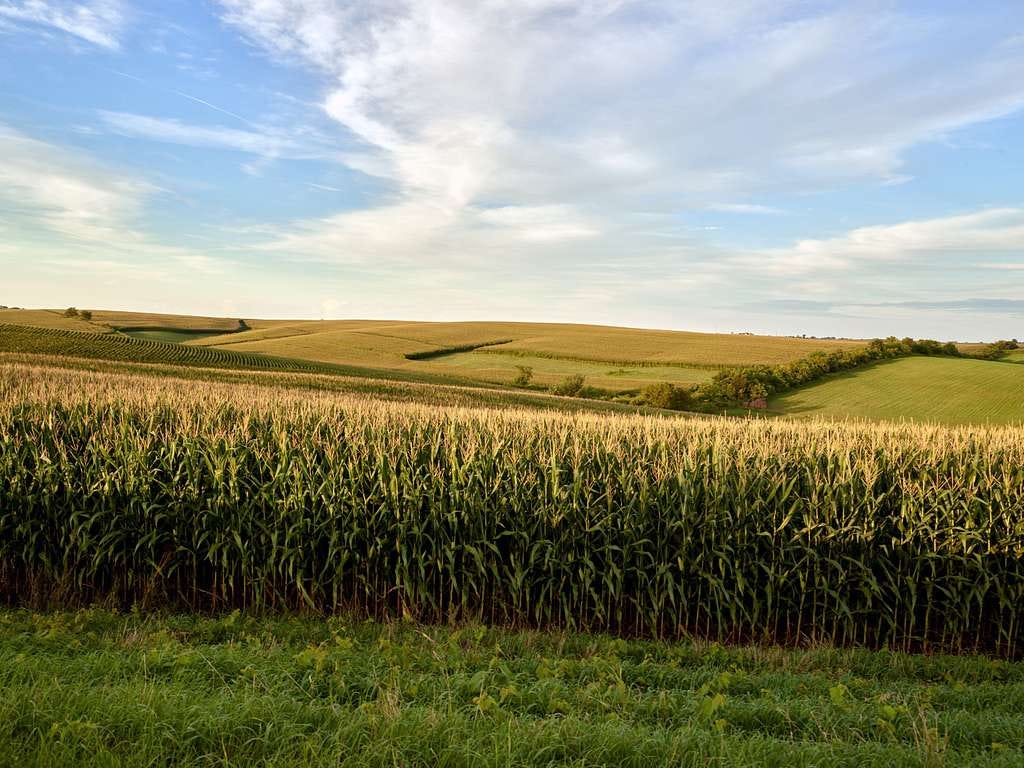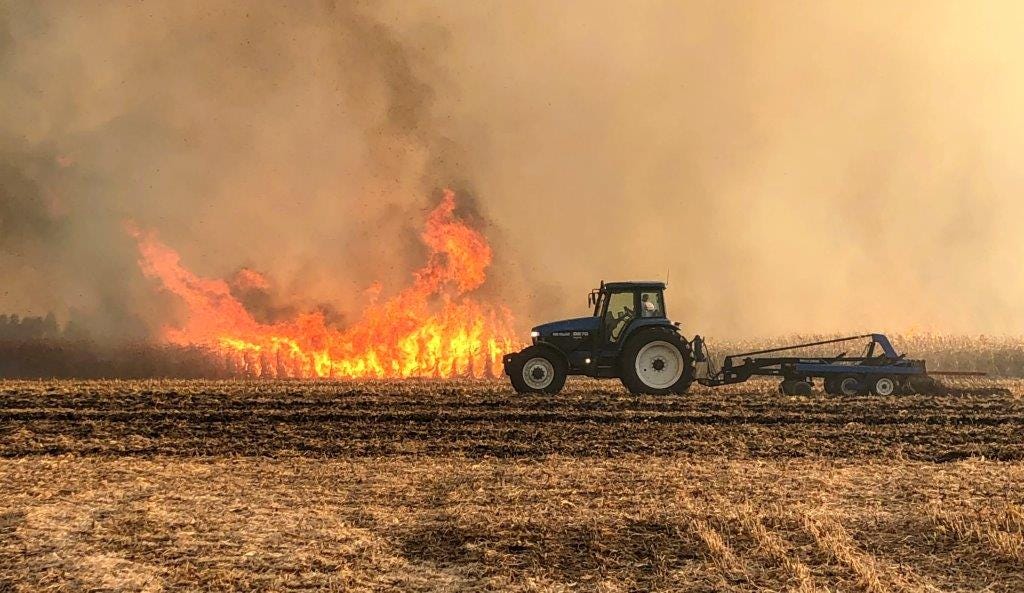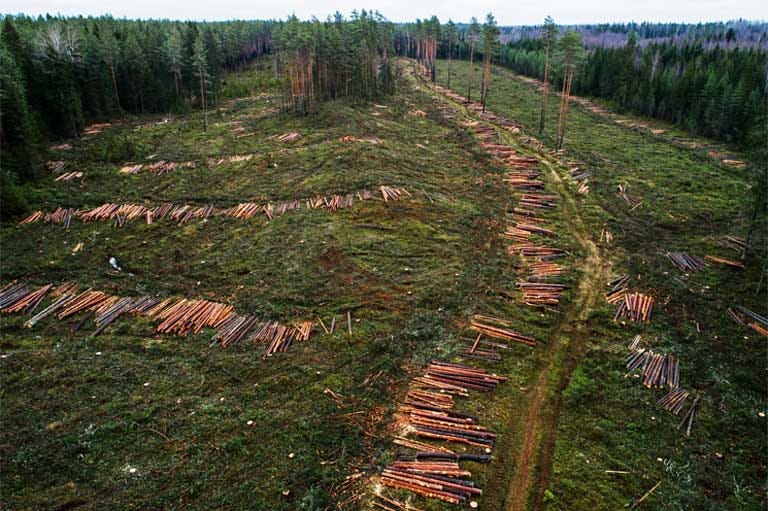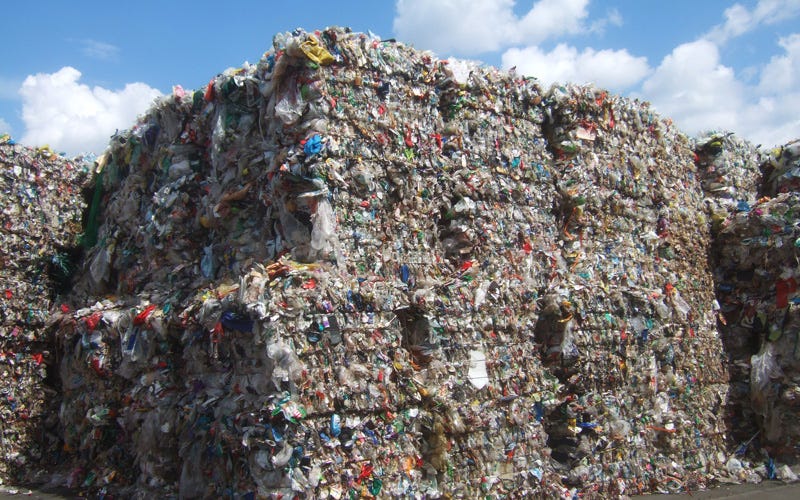Problems Posing as Solutions, Part 2
6/22/23 – This week, just say no to ethanol, wood biomass, and plastics pyrolysis
Hello everyone:
One quick follow-up to last week: Anthropocene magazine just put out a brief and excellent summary of the carbon credits quandary, building on a sharp critique they published back in February. Both are concise and worth reading.
As always, please remember to scroll past the end of the essay to read some curated Anthropocene news.
Now on to this week’s writing:
My problem-posing-as-solution topics this week are each subject to the elegant phrasing by
of our energy problem: “We need to stop burning things.” It sounds cute, but he means it. And he’s right. It’s a mantra that should be etched in stone, graffitied on every highway overpass, and muttered by anyone losing sleep out of concern for life on Earth.This phase of Earth history, shaped by human activity, may be better called the Pyrocene rather than the Anthropocene. Those of you who’ve been with the Field Guide long enough might remember “An Age of Fire,” my writing on the Pyrocene. The name comes from the brilliant Stephen Pyne, likely the foremost scholar on the cultural history of fire, who ascribes much of the Earth’s man-made transformation to our long-running relationship with burning things. “Fire,” Pyne writes,
brought us power. We got small guts and big heads because we learned to cook food. We went to the top of the food chain because we learned to cook landscapes. Now we have become a geologic force because we have begun to cook the planet.
We are now in the fire equivalent of an ice age, he says, and explains that
We have too many bad fires – fires that kill people, burn towns, and trash valued landscapes. We have too few good ones – fires that enhance ecological integrity and hold fires within their historic ranges. At the same time, with the incessant burning of fossil fuels, we have too much combustion on the planet overall. How did fire’s presence on Earth become so deranged?
For a quick glimpse of the scale and state of the derangement, check out a new CNN article highlighting recent spikes in global warming with four frightening graphs. A spooky spike in ocean temperatures has been in the news, but it mirrors the sharp increase in air temps and CO2 levels and the dramatic decrease in Antarctic sea ice.
So, this is scarcely the time to be burning new things, unless there’s a bit of magic involved that makes the burning useful for cooling the planet and helping plants and animals reclaim their full, rich ecologies. There’s a bit of that magic happening, I think – wisely-managed biochar comes to mind – but not much. This week, then, I’ll look at a few of the more deranged plans for burning things that are haunting the search for solutions.

Ethanol
Ethanol production in the U.S. is, in a word, infuriating. Imagine a worst-case scenario in which government devotes billions of dollars in subsidies to major agribusiness corporations for an unnecessary fuel that drives up the cost of food globally, is bad for engines, takes up valuable farmland, wastes huge amounts of water, increases pesticide and herbicide use, intensifies fertilizer run-off into waterways, erases biodiverse habitat, worsens climate change, and does so for small-scale political gain. That’s ethanol.
I should take a breath and note that ethanol is a biofuel. Biofuels, as a category of chemicals and/or climate-related solutions, are complicated. They range from biodiesel made from waste oil in food production to algae-based fuels to syngas derived from pyrolytic burning of biomass.
Further, there are “first generation” and “second generation” (also known as “advanced”) biofuels. First-generation biofuels come from crops grown on good land, whereas second generation are either derived from the waste materials of crop production or grown on “marginal” land. Current research is driving second-generation options, in an effort to get away from the problems of first-generation production, but results are mixed. It may be “advanced,” but it’s still making energy by burning things.
I don’t have the time or space to explore the larger biofuel question here, but I’ll offer this as an Anthropocene rule of thumb. If the large-scale production of a biofuel 1) increases CO2 levels or is merely carbon-neutral rather than an effective carbon sink, 2) isn’t cost-effective, 3) displaces food crops with crops grown for fuel, or 4) erases habitat and reduces biodiversity, it’s a disaster.
Which brings us back to American ethanol, the most criminal of the biofuels. There are other bad first-generation biofuels, certainly, like Brazilian ethanol derived from sugarcane grown in the Amazon, Indonesian palm oil grown where tropical forests once stood, or the soy biodiesel grown in the U.S. under the same political/economic subsidized nonsense as ethanol. But the scale of ethanol and its impacts are staggering.
The U.S. is by far the largest corn producer in the world (producing almost as much as China and Brazil, the #2 and #3 growers, combined), but nearly 40% of U.S. corn is diverted to ethanol. Because ethanol production doesn’t make economic sense, American taxpayers have spent tens of billions of dollars over the last 40 years supporting the industry with subsidies and tax breaks. With all that money in the offing, agribusiness has increased production of corn (and soy for biodiesel) significantly, converting wildlands into farmland and turning away from growing corn for food. The consequences, as I noted in my first paragraph here, are grotesque.
As an excellent recent op-ed by Michael Grunwald in the Times lays out, ethanol is as ethically-challenged as it is inefficient:
What makes corn-based ethanol distinct from most of our other wasteful agricultural giveaways is that it diverts crops from bellies to fuel tanks and uses almost as much fossil fuel – from fertilizers made of natural gas to diesel tractors, industrial refineries and other sources – as the ethanol replaces.
And now, as the global shift to electrification through solar and wind is taking place, the negligible value of most biofuels has been reduced to zero. Grunwald lays out the stark fact that “It takes about 100 acres worth of biofuels to generate as much energy as a single acre of solar panels.”
Here are a few more factoids to get you fired up about ethanol:
Any biofuel production that results from conversion of forests, wetlands, and grasslands actually increases greenhouse gas emissions, because those ecosystems sequester carbon while monoculture crops squander it.
Depending on who you ask, it takes anywhere from 3 to 1,700 gallons of water to produce a gallon of ethanol. (The larger number accounts for irrigation of the corn.)
Remember the price shock for grains around the world when Russia invaded Ukraine? If the U.S. and Europe (which mostly produces biodiesel) cut their biofuel production in half, they could replace all of Ukraine’s grain exports on the world market, making it easier for poor people to feed themselves.
Also, Grunwald makes an analogy I want to include here, because I think it speaks to the weirdness of bad biofuels in the 21st century:
Biofuels are like a return to the horse-and-buggy era, when farmers had to grow millions of acres of oats and hay for transportation fuel, except now the crops are processed through ethanol plants instead of animals.
In the final analysis, then, first-generation biofuels like ethanol are making two very, very important 21st century jobs much harder: 1) Growing food for an increasing and resource-hungry population in a hotter world, and 2) conserving the natural world and rewilding much of what we’ve hijacked for agriculture. As Grunwald puts it, biofuels are “climate nightmares masquerading as climate solutions, and they’re making life harder for some of the poorest people on earth.”
Wood biomass
Any energy we derive from burning things – trees, coal, oil, etc. – was first obtained from the Sun. The miracle of electrons converted by cellular life into baobabs, apples, and other neighbors underlies everything that happens on what should be just another cold rock in space. Life starts and ends in the Sun; all that we know (and don’t know) is just an exchange of energy.
Here in my little green corner of Earth, I’ve spent much of my adult life heating the house with wood in the wood stove. In ecological terms, the trees were a step in a transaction between me and the star at the center of our solar system. In terms of physics, though, the trees and I are indistinguishable clusters of cells borrowing the Sun’s energy for a moment. In the end, the trees and I will give up similar ghosts, usually through what Robert Frost called “the slow smokeless burning of decay.”
Burning trees – wood biomass, in industrial terms – is a solid form of biofuel. There are many other sources for solid biofuel – canola, switchgrass, corn, soy, sugar cane, and rice husks, to name a few – which can be converted into charcoal, liquid fuels, or gases. That’s a reminder of the complexity of biofuels I mentioned earlier. But it’s the terrible push to burn trees for energy I want to talk about here, because there’s a lot of “renewable” energy policy being based on the bizarre idea that we can cool the planet by burning wood.
Biomass energy has been increasingly popular, especially in Europe, where biomass produces more energy than wind and solar combined, due largely to billions in biomass subsidies. Burning wood is a renewable energy humans have used since time immemorial. At this critical moment in history, the enthusiasm for it has been built around the assumption that burning trees for energy is carbon-neutral. Cut a tree down, they say, and another one grows in its place, absorbing the emitted carbon from the burning of its predecessor. The cycle of life, right? Yes and no.
The first problem is that when forests fall there’s a loss of a living community upon which many other living communities depend, including ours. That’s a loss we simply can no longer suffer; too much has been lost already. Secondly, far too often the harvested trees aren’t “replaced” when the felled forest becomes repurposed for industry, agriculture, or development. And thirdly, as Bill McKibben writes, even when the natural regeneration process occurs uninterrupted by human affairs, there’s a problem with the timeframe of what’s called the “carbon payback period”:
it takes a long time for a tree to regrow and suck that carbon back up – it’s decades before the damage is repaired, and it is precisely those decades that are going to break the back of the planet’s climate system. So while biomass energy might in some technical sense be “renewable,” it’s in actual practice disastrous.
In the Anthropocene, he says, wood biomass is little better than burning coal. In fact, Peter Wohlleben, writes in of The Heartbeat of Trees that a British government study found that “burning wood pellets is up to three times more detrimental to the carbon balance of the planet than burning coal.”
This is a hard lesson in a world desperately grabbing at straws (to burn), but it is slowly being learned.
For example, to see how the climate crisis might play out if we keep burning wood for energy, take a look at the sophisticated EN-ROADS climate exploration tool, which allows you to play out numerous scenarios for how we might, at the policy level, respond to the crisis. You can increase or decrease taxes on fossil fuels and nuclear, enhance afforestation and slow deforestation, adjust population growth rates, and more. One new option they’ve included is to subsidize or tax bioenergy sources. You can see their full technical discussion of the impacts of our continuing to subsidize this bad idea, but here’s the summary: burning trees and other biomass “increases CO2 emissions, reduces the removal of CO2 from the atmosphere, and competes with other sources of energy.”
For an on-the-ground reality check about the impacts of wood biomass, look no further than a sobering investigative article on the wood pellet industry by Mongabay from last December. A whistleblower from management at Enviva, the world’s largest wood pellet manufacturer, which siphons up forests in the southeast U.S. and sells them to Europe and elsewhere, says that
We take giant, whole trees. We don’t care where they come from. The notion of sustainably managed forests is nonsense.
And
The company says that we use mostly waste like branches, treetops and debris to make pellets. What a joke. We use 100% whole trees in our pellets. We hardly use any waste. Pellet density is critical. You get that from whole trees, not junk.
The Mongabay reporter observed Enviva harvesting operations and watched large mature oak trees disappearing into the machinery. As McKibben wrote in response to this reporting, “It seems pretty clear that the idea you could supply massive quantities of pellets just using wood waste is a fiction; if you’re trying to make a fortune, cutting down whole trees is probably the only way to go.”
One bright light amid this darkness is that the Netherlands voted to cancel subsidies for wood pellets because of the Mongabay reporting, eliminating what would have been $10 billion over the next decade. Australia, too, has moved in the right direction, becoming the first major nation to refuse to allow biomass from native forests as a renewable source of energy. Biomass is still gathering steam, though, so there’s work to do to save forests from this planet-killing boondoggle.
The good news is that solar and wind energy production costs have plummeted. Biomass simply isn’t any more necessary than it is sensible. We need more living, unmolested forests (and peatlands, grasslands, wetlands) and we need to let them grow old, which is when they do their best work for us, for the atmosphere, and for the larger community of life. As McKibben says,
The bottom line is so obvious: Humans must stop setting things on fire. Not coal, not gas, not oil, and not industrial quantities of wood. We can end that 700,000-year-old habit of combustion in a matter of years if we really try – relying instead on the fact that the good Lord hung a large ball of burning gas 93 million miles up in the sky and endowed us with the wit to make full use of it.
In other words, why not cut out the industrial middleman and get the energy where the trees got it from? The trees can get theirs and we can get ours, all of us with our grateful faces turned toward the Sun, thriving together.
Pyrolysis
Plastics are a toxic nightmare sold to us for nearly a century as a magic solution to every aspect of our lives. That sales pitch originated with the fossil fuel and petrochemical industries. Despite the constant messaging about their benefits (ranging from unnecessary single-use conveniences to medical necessities), the plastic objects and surfaces you and I touch all day, every day, are a soup of petrochemical toxins in solid form.
The toxicity varies from product to product, and may be worse after it leaves our hands and ends up in a landfill or the ocean, but it’s important to remember that the extent to which we’ve toxified our lives (and the lives of other species) with plastics is so thorough and vast that it’s hard to fully articulate.
Microplastics are literally everywhere on Earth, from Antarctica to the Arctic and from the atmosphere to ocean trenches. We eat it, drink it, breathe it, and absorb its chemistry through our skin. Bottle-fed babies consume millions of microparticles a day. Whether drifting in the oceans or infiltrating sperm, breast milk, and fetuses’ reproductive systems, plastic chemistry disrupts the hormonal chemistry of species in every living community, and may do so for centuries or millennia to come. Their toxic ubiquity, like that of the fossil fuels they’re derived from, has been a Faustian bargain, and the consequences now literally rain down upon us.
As bad as all that is, there is another new petrochemical threat being pitched by industry for public acceptance. It’s called plastics pyrolysis, and it amounts to heating pellets of mixed plastic waste (by burning fossil fuels) to very high temperatures in a zero-oxygen environment, so that the industry can turn it into more toxic products (fuel and plastics) to sell to us. This effort is being sold as “advanced recycling,” “chemical recycling,” or “plastics renewal,” and it’s described as an effort to rein in plastic waste and create a “circular plastics economy.” But plastics pyrolysis is likely to be none of those things.
It looks instead to be a false and poisonous solution to the wicked problem of nonrecyclable plastics, created as a smokescreen to 1) keep societies hooked on fossil fuels and plastics, 2) delay or avoid the necessary reduction of plastic production, and 3) hide the industry’s effort to triple global plastic production in the years ahead as fossil fuels are decoupled from transportation.
It’s not clear that pyrolysis will work at scale, or that the solution won’t cause more problems than it solves. Most of what emerges from the pyrolysis process is fossil fuels to be burned, which means we’ll need more virgin fossil fuels to make new plastics. If what we’re recycling and reusing is a planetary hazard, then what’s the point?
But billions of dollars are being thrown at pyrolysis through an assortment of start-ups wrestling with complex and explosive petrochemical chemistry. “Plastic is made with thousands of chemicals,” one critic explained, “and many, especially when mixed together, are incompatible with the processes like pyrolysis.” That’s from an investigative article by Inside Climate News, which also revealed that the industrial processing of these plastics can be dangerous and toxic, with workers battling hard-to-extinguish refinery fires and inhaling clouds of plastic dust.
Likewise, scientists at the Dept. of Energy found that the economic and environmental costs of making new products through plastics recycling was 10 to 100 times higher than making plastics from new fossil fuels. And a joint investigation by ProPublica and the Guardian revealed that a planned Chevron refinery for processing pyrolysis fuels “could emit air pollution that is so toxic, one out of four people exposed to it over a lifetime could get cancer.” That risk is 250,000 times higher than the EPA usually allows, yet the EPA approved the fuel production without “any lab tests, air monitoring or controls that would reduce the release of the cancer-causing pollutants or people’s exposure to them,” in part because of the Biden administration’s effort to streamline permitting for fossil fuel alternatives… Unsurprisingly, the refinery operates near a low-income, mostly Black community in Pascagoula, Mississippi.
I’m not sure we needed more evidence that there’s no viable future in which we keep burning large amounts of fossil fuels, but here it is. It doesn’t matter if those fuels are new or “recycled.”
Finally, then, an excellent Financial Times profile of Shanna Swan, an 87-year-old researcher who has devoted her life to understanding the harms of EDCs (endocrine disrupting chemicals), concludes with this:
Her overriding preoccupation remains how to alert a still largely oblivious world to the threat from EDCs. “You and I, and everyone on this planet, are really serving as guinea pigs,” she says. “And nobody asked us.”
Let’s not be guinea pigs for the plastics pyrolysis experiment. We have too many other burning issues to resolve.
Thanks for sticking with me.
In other Anthropocene news:
From Time, a final word from Roger Payne, biologist, environmentalist, and producer of the famed 1970 album, Song of the Humpback Whale, which gave the world recordings of the whales and the inspiration to save them. He died recently, but not before publishing his thoughts on the value of the living world:
The way I see it, the most consequential scientific discovery of the past 100 years isn’t E = mc2 or plate tectonics or translating the human genome… It is this: Every species, including humans, depends on a suite of other species to keep the world habitable for it, and each of those species depends in turn on an overlapping but somewhat different suite of species to keep their niche livable for them.
From Inside Climate News, a persuasive piece describing the conservation potential of regenerative cattle ranching. Not much of it is being done, and some claims are more greenwashing than true, but done with a deep knowledge of the land and its ecology, managing cattle with biodiversity in mind can help restore habitat that’s lost its bison in the mad rush to turn the American west into a cattle feedlot.
From Bill McKibben’s newsletter The Crucial Years, more on that truly frightening spike in ocean surface temperatures this year. It is, as he says, way off the charts, and a sign of what’s to come.
From the Post, the infuriating news that insurance companies are still funding fossil fuel extraction while getting out of the business of insuring people and communities suffering the catastrophes they cause.
Lots of news about the U.S. electrical grid these days, like these: 1) From Canary Media, there’s a mind-bogglingly massive backlog of planned renewable energy projects. The combined electric potential of those projects is double that of all existing power infrastructure. For various reasons, including the bottleneck itself, many of them won't be built. 2) From the Times, why the U.S. grid isn't ready for the energy revolution. And 3) from Inside Climate News, energy utilities are paid to maintain the grid, but some states are experimenting with paying them based on performance. Some experts think this might be a good step toward making them focus on the energy revolution.







Great series and reporting. Thanks.
Another solid, sobering round of reporting. Thanks, Jason. I wonder if you know what percentage of wood-burning comes from households (like yours and mine) compared to wood-fired (wood chips, I guess) power plants.